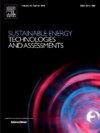了解小规模太阳能海水淡化(太阳能蒸馏、加湿-除湿)对实现发展中国家可持续发展目标(sdg)的作用:综述
IF 7.1
2区 工程技术
Q1 ENERGY & FUELS
Sustainable Energy Technologies and Assessments
Pub Date : 2025-07-03
DOI:10.1016/j.seta.2025.104423
引用次数: 0
摘要
本文讨论了各种配置的小型太阳能海水淡化系统与通过增加发展中国家饮用水获取来实现联合国可持续发展目标(sdg)之间的复杂相互关系。非常重要的是,本文讨论了在许多国际行动计划和sdg文书中宣布的饮用水的四个基本和重要标准(及其与实现sdg的关系):可负担性,可及性,质量和数量。从技术和经济的角度来看,太阳能蒸馏器和加湿-除湿(HDH)在这种情况下被认为是小规模的太阳能海水淡化系统,因为两者都是实用的,目前在实际应用中工作。然后,关于主要的国际法文书,包括可持续发展(2030议程),21世纪议程,联合国第15号一般性意见,都柏林声明等(主要关注2030议程),得出的结论是,在发展中国家使用这些系统将向前迈进一步,以增加获得安全饮用水的“可持续发展目标6的目标6.1”。此外,还阐明了使用小型海水淡化系统提供符合上述标准(可负担性、可及性、质量和数量)的饮用水,有助于为实现其他可持续发展目标(包括可持续发展目标3、可持续发展目标4和可持续发展目标11)制定步骤。事实上,可持续发展目标6(清洁水)与包括可持续发展目标3(良好健康和健康)在内的其他目标之间的直接和间接相互关系;阐述了可持续发展目标4(素质教育)和可持续发展目标11(可持续城市和社区)。本文章由计算机程序翻译,如有差异,请以英文原文为准。

Understanding the role of small-scale solar desalination (solar still, humidification-dehumidification) to achieving sustainable development goals (SDGs) in developing nations: a review
In the present critical review, the complex interrelation of small-scale solar desalination systems with various configurations to provide safe drinking water, in relation to achieving the United Nations Sustainable Development Goals (SDGs) by increasing the access to drinking water in developing countries is discussed. Of great importance, this paper deals with four essential and important criteria of drinking water (and their relation for realizing SDGs) that declared in numerous international action plans and instruments of SDGs which are: Affordability, Accessibility, Quality and Quantity. Solar stills and humidification-dehumidification (HDH) were considered in this context as small-scale solar desalination systems from technical and economic point of views since both are practical and currently work in real-world application. Then, regarding to the main international law instruments, including Sustainable Development (2030 Agenda), Agenda-21, General Comment No.15 of the UN, Dublin Statement etc. (with the main focus on 2030 Agenda), it is concluded that using these systems in developing countries would be one step forward to increase access to safe drinking water “Goal 6.1 of SDG 6”. Also, it was elucidated that using small-scale desalination systems to provide drinking water regarding the above-mentioned criteria (Affordability, Accessibility, Quality and Quantity) could assist for putting steps on the realization of other SDGs including SDG 3, SDG 4 and SDG 11. Indeed, the direct and indirect interrelation between SDG6 (Clean Water) with other goals including SDG 3 (Good Health & Well-Being), SDG 4 (Quality Education), and SDG 11 (Sustainable cities and Communities) were elucidated.
求助全文
通过发布文献求助,成功后即可免费获取论文全文。
去求助
来源期刊

Sustainable Energy Technologies and Assessments
Energy-Renewable Energy, Sustainability and the Environment
CiteScore
12.70
自引率
12.50%
发文量
1091
期刊介绍:
Encouraging a transition to a sustainable energy future is imperative for our world. Technologies that enable this shift in various sectors like transportation, heating, and power systems are of utmost importance. Sustainable Energy Technologies and Assessments welcomes papers focusing on a range of aspects and levels of technological advancements in energy generation and utilization. The aim is to reduce the negative environmental impact associated with energy production and consumption, spanning from laboratory experiments to real-world applications in the commercial sector.
 求助内容:
求助内容: 应助结果提醒方式:
应助结果提醒方式:


